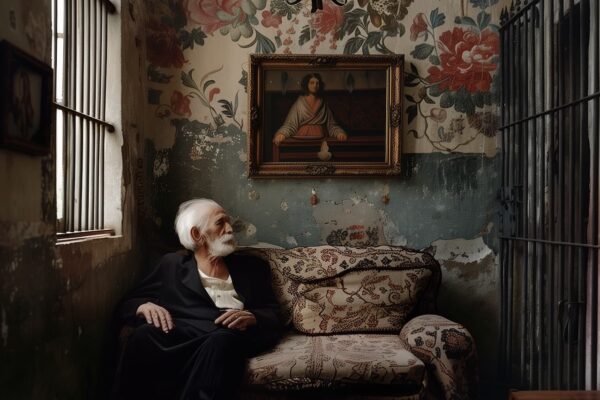Are you planning to visit one of Rome’s most important attractions and want to know what works are inside Castel Sant’Angelo?
In this post, we discover together all the works of Castel Sant’Angelo, starting with the statues, then talking about the paintings and finally the architectural works.
Are you ready? Let’s get started!

Castel Sant’Angelo Rome Tickets: Quick Access
Buy online. Choose your preferred time. Visit Rome’s Castel Sant’Angelo, Hadrian’s Tomb, the papal quarters, the fortress and much more.
You can cancel free of charge up to the day before the visit.
Contents
What’s Inside Castel Sant’Angelo
Architectural Works
Misericordia Bell
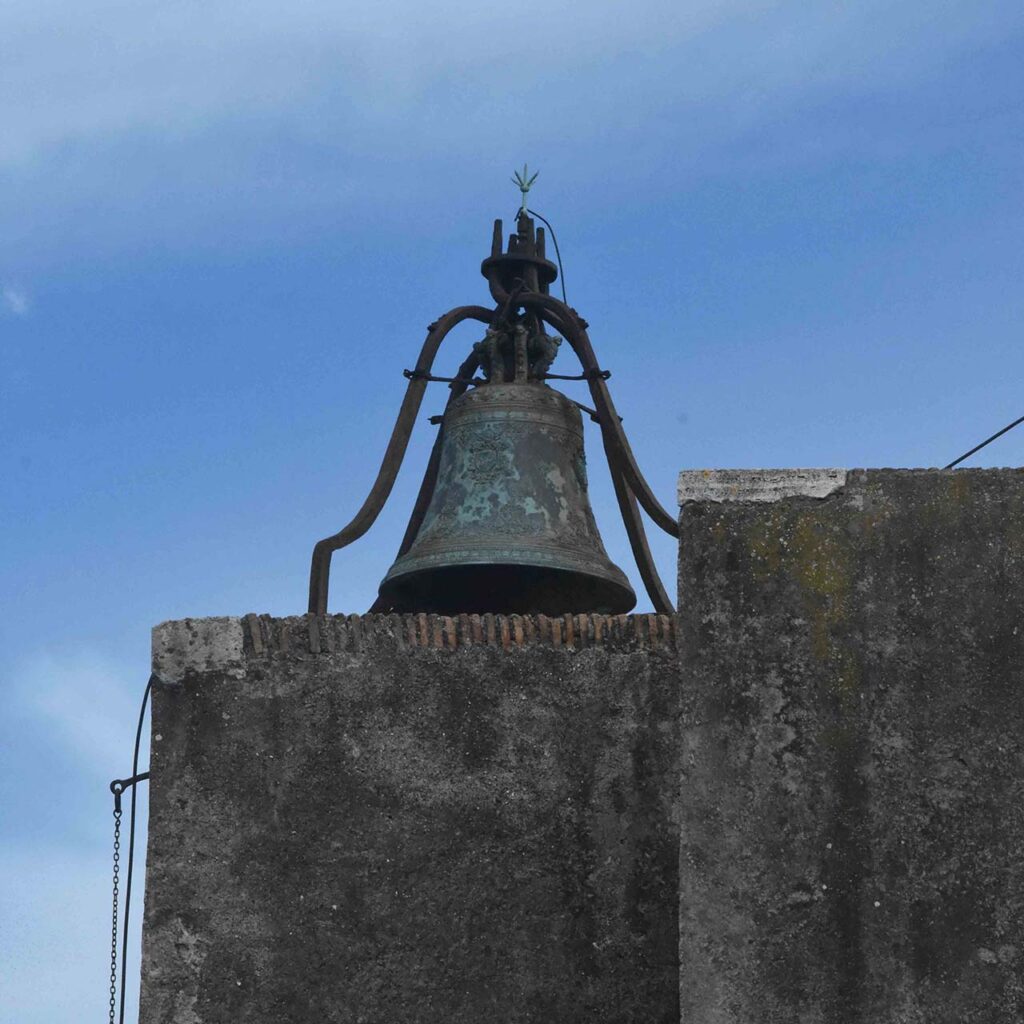
This bell, located in the centre of the castle, is an imposing bronze structure with decorative carvings dating back to the period of the Roman Empire. Used in the past for signalling important events and for religious purposes, it is an icon of the castle’s history and spirituality.
Corinthian capitello

This capitello, with its intricate details and elegant form, is a superb example of Roman architectural art. Decorated with acanthus leaves and other ornamental motifs typical of the period, it represents the refinement and grandeur of classical architecture.
Banner of the Bombardiers of Castel Sant’Angelo
Made of precious fabric and richly decorated, the bomber banner is a symbol of the castle’s military strength and glory. Its images represent the heroic deeds of the soldiers who have defended the structure over the centuries.

Castel Sant’Angelo Rome Tickets: Quick Access
Buy online. Choose your preferred time. Visit Rome’s Castel Sant’Angelo, Hadrian’s Tomb, the papal quarters, the fortress and much more.
You can cancel free of charge up to the day before the visit.
Paintings
Cavalier d’Arpino, Portrait of Prospero Farinacci
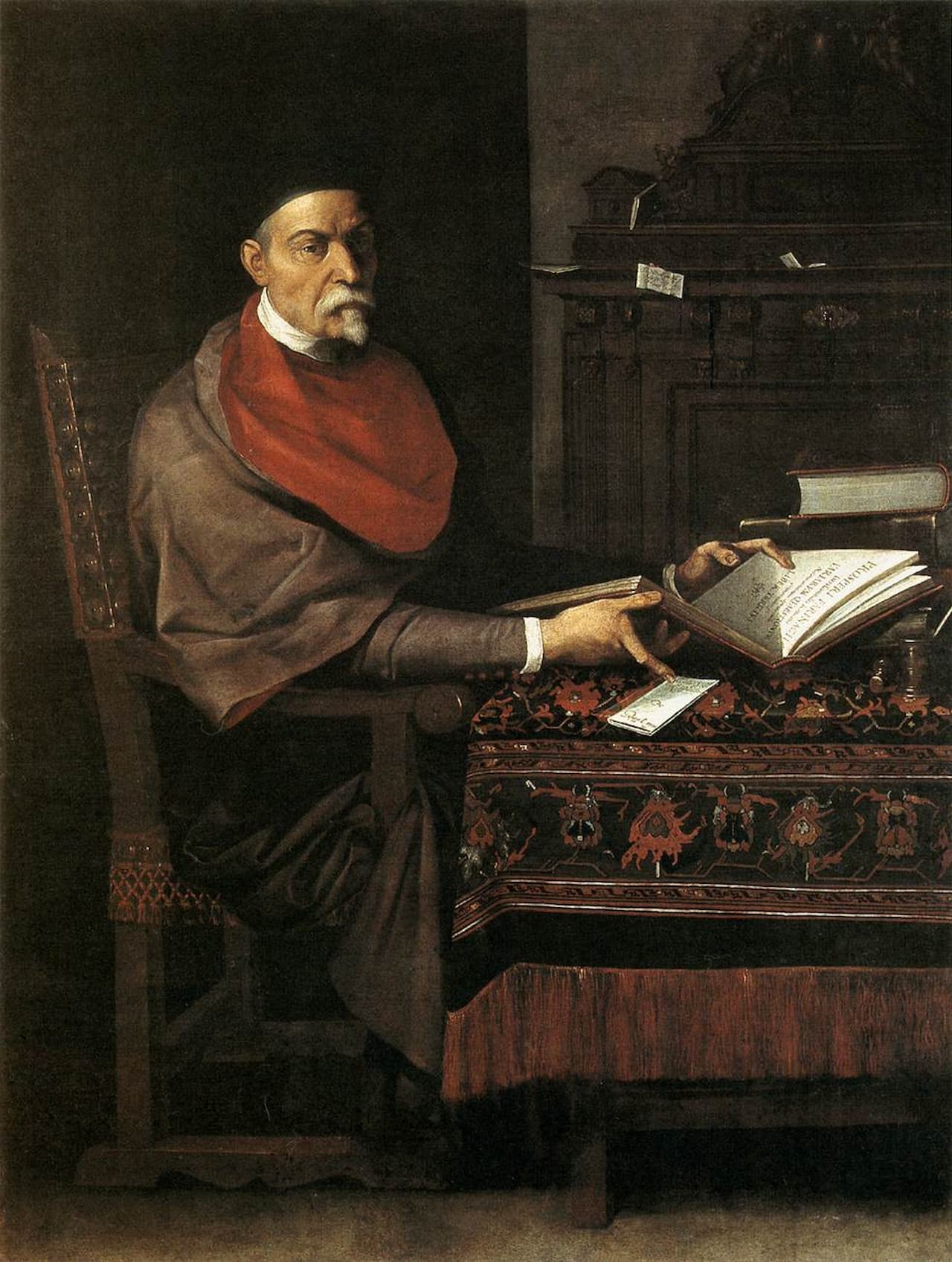
Portrait of Prospero Farinacci: Source Wikipedia
In Cavalier d’Arpino’s Portrait of Prospero Farinacci, we are confronted with an image that captures the essence of a severe, elderly man, seated in front of a table in a sober study. His serious expression reflects the depth of his thoughts as he holds open a book and points with his finger to a letter addressed to the ‘Tax King of Rome for Gioseppe d’Arpino‘. This signature and dedication by the artist to the man portrayed, the renowned jurisconsult and lawyer Prospero Farinacci, are details that add special meaning to the painting.
This work, a rare example of portraiture by Cavalier d’Arpino that has survived to the present day, has been dated to 1607 by art historians. That year, the artist was involved in a trial for illegal possession of firearms, an event that marked his life and career. The Farinacci, as tax attorney general, may have played a key role in this affair, and the portrait may have been a gesture of gratitude or even a form of reward for services rendered.
This representation not only offers us a glimpse into the imposing figure of Farinacci, but also leads us into the meanders of history and politics of the period, adding an extra fascination to this precious work of art.
Carlo Crivelli, Christ Blessing

The two small panels, originally part of an altarpiece depicting The Coronation of the Virgin, were part of the artistic complex that adorned the church of San Francesco in Fabriano.
This altarpiece, completed in 1493 and signed by the famous Carlo Crivelli, was destined to be the full of religious veneration within the church. The panels, together with ten other depictions of saints, were part of the predella that was placed inside an arched window.
However, during the 18th century, the church underwent reconstruction and the artwork was removed. The central altarpiece, showing The Pietà and the Coronation, is now housed in the Brera Gallery in Milan. The Predella, on the other hand, was divided and dispersed into various parts, ending up in private collections in France and Hungary.
The two panels in question, depicting The Blessing Christ and St. Onofrio, probably occupied respectivelythe centre and the right-hand end of the predella, as suggested by the arrangement of the figures and their relation to the surrounding space.
The style of these works is characterised by precise and meticulous drawing, typical of the later stages of Crivelli‘s artistic career, which favoured the expressiveness of details rather than colour rendering. This is evident in the intense expression of Saint Onofrio, whose tormented face conveys a profound emotionality to the viewer.
Lamentation over the Dead Christ
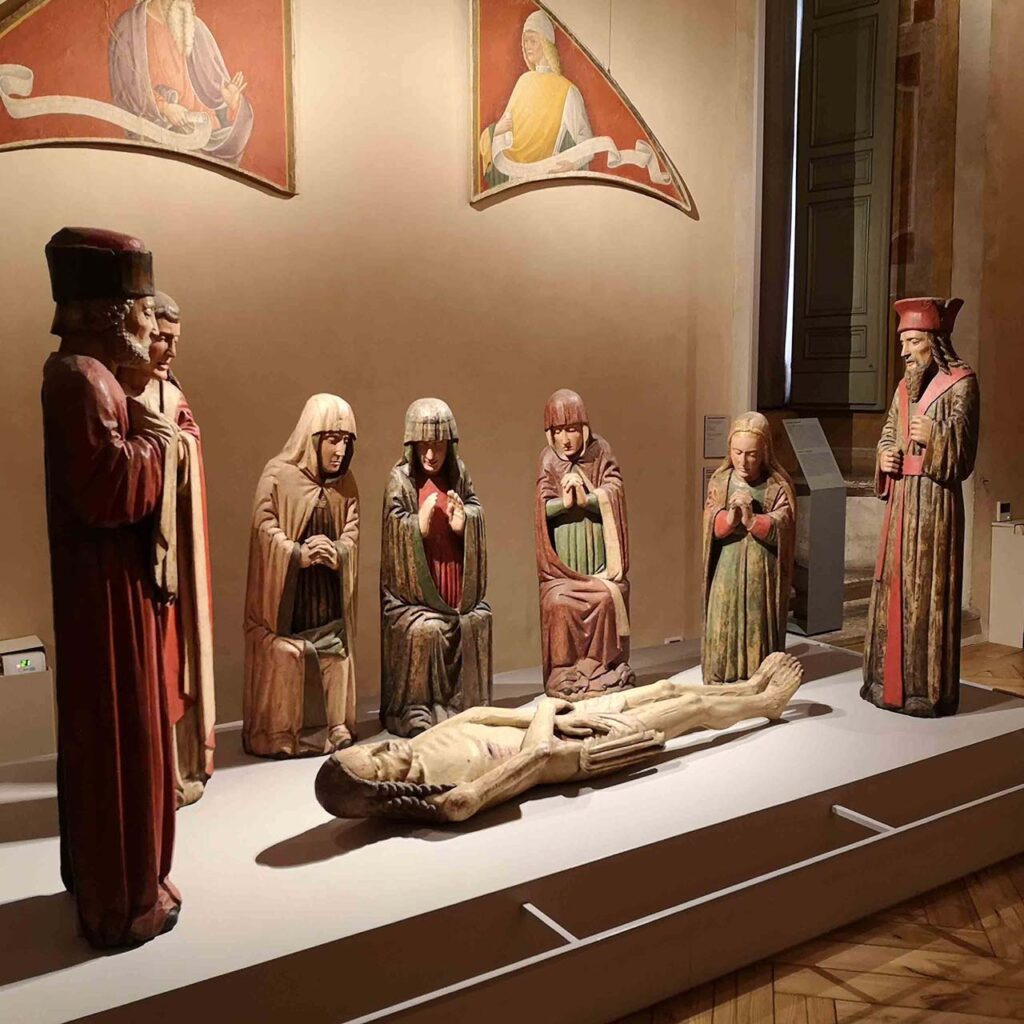
The sculptural group around the body of Christ just deposed from the cross is a powerful portrait of the seven sorrowful figures surrounding the crucial moment in Christian history. Nicodemus, young John the Evangelist and the three Marys stand next to the Virgin, easily identifiable by her traditional red robe and blue mantle. Joseph of Arimathea, originally depicted with the nails of the cross and the hammer in his hands, closes the group.
The figures display an archaic composure that contrasts with the strongly pathetic expressions of the faces, creating an exciting contrast. This tradition of wooden groups dedicated to this devotional theme, of transalpine origin, spread to northern Italy in the early 15th century and found great success in the following centuries.
The author of the group, unfortunately, remains unknown, but recent studies suggest that it may have been realised by a specialised workshop, probably of Lombard-Piedmontese origin but active in the Ligurian area. Among the proposed comparisons, one can note similarities with the Lamentation in the Museo Civico di Arte Antica in Turin, a work by Domenico Mezzagora dated to the end of the 15th century, and with the wooden crucifix in the church of Sant’Ambrogio in Varazze, dating back to 1440-50, particularly with regard to the figure of Christ.
Grotesque decoration – detail (Cagliostra)
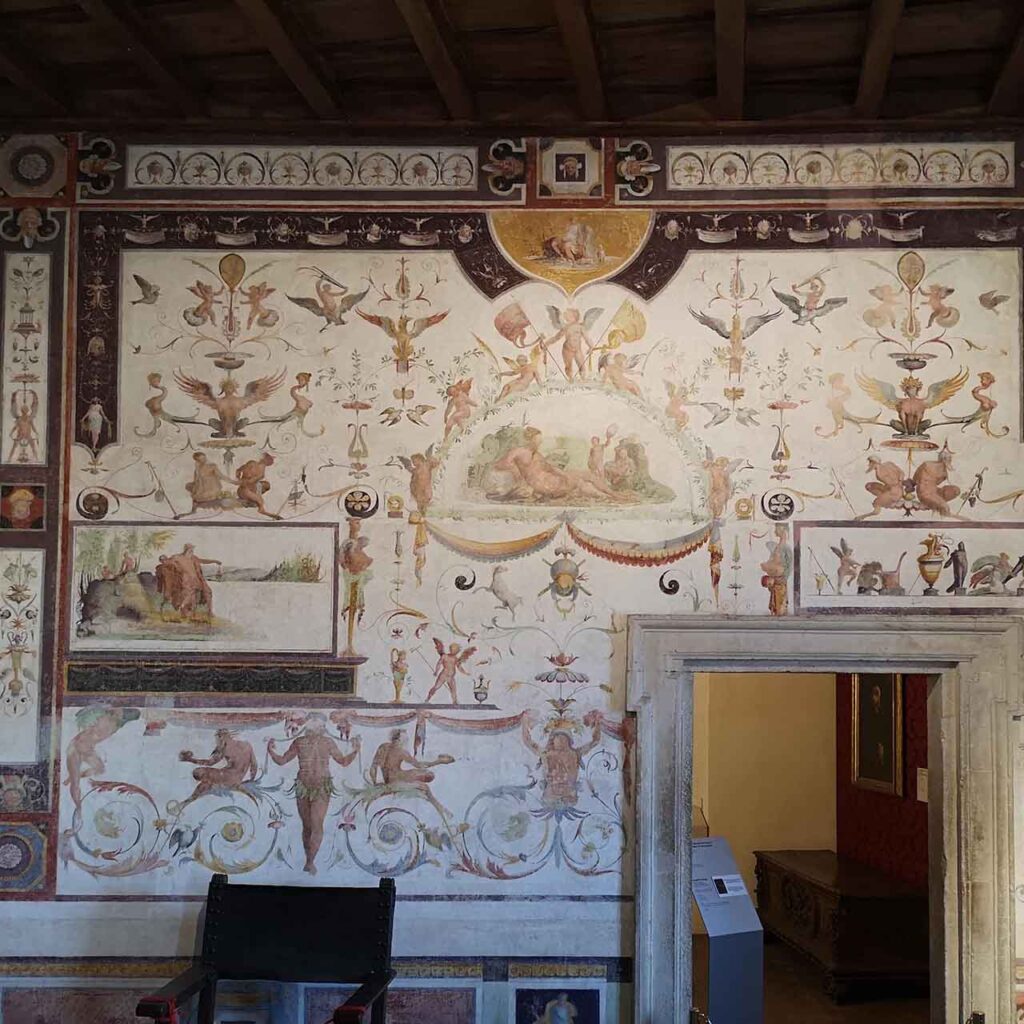
The decorative taste of grotesques, which developed into an autonomous artistic style during the Renaissance, has its roots in the ancient traditions of painted or relief ornaments found in the buildings of ancient Rome. This characteristic style consists of a variety of small figures, made of stucco or painted in fresco, on a neutral background. Masks, geniuses, intricate plant forms, human, animal and monstrous creatures alternate with mythological scenes and landscapes set between fanciful frames.
The first mentions of this type of decoration date back to Vitruvius and Pliny, who described them as leisure elements to embellish the interior of dwellings. Significant examples of this style can be found in the House of Livia at Prima Porta and at Pompeii, including the House of the Faun, the Villa of the Mysteries and the House of the Vetii. In 16th century Rome, the stucco decorations on the arches of the Colosseum inspired numerous artists, such as Luzio Romano, who reproduced them in many drawings.
However, the discovery in 1480 of the ‘Grottoes’ of Nero’s Domus Aurea in Rome gave new impetus to the artists of the 15th and 16th century. These artists, influenced by humanistic ideals, regarded Roman antiquity as a golden period for art and culture. Artists such as Brunelleschi, Donatello and Raphael explored the Grottoes, initiating an artistic revival that involved many other artists of the period, such as Giovanni da Udine, Giulio Romano and Perin del Vaga.
This artistic revival found expression in works such as Cardinal Bibbiena’s Loggetta and Stufetta in the Vatican Palace, the Vatican Loggias, Villa Madama and the papal flats in Castel Sant’Angelo. The popularity of grotesques continued over the following centuries, with artists such as the Zuccari brothers decorating the Palazzo Farnese in Caprarola. With the discovery of Herculaneum and Pompeii in the 18th century, the taste for this exuberant style was renewed, also influencing the applied arts.
The Bath of Dosso Dossi
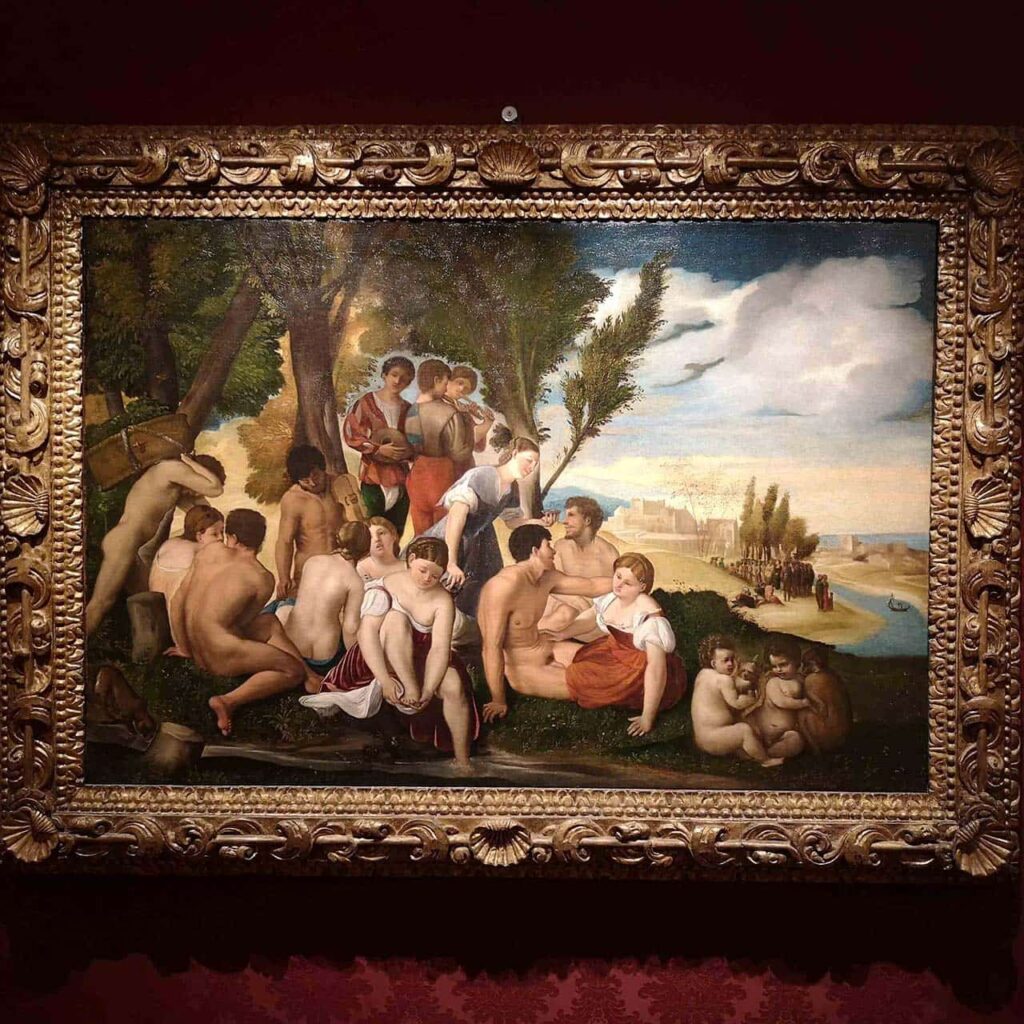
In this enigmatic painting, a group of men and women gather on the bank of a river in a quiet clearing. Some of them are playing musical instruments, while the nude figures suggest an erotic theme. In the foreground, two cupids play with a dog and a monkey, symbols that may evoke both fidelity and lust.
The author of this work is Dosso Dossi, one of the most enigmatic artists of the Italian Renaissance. This painting, known as ‘Il Bagno’, has long been identified as the ‘bagnaria d’huomeni’ mentioned by Giorgio Vasari in the alabaster chamber of Alfonso d’Este in Ferrara. However, it is believed to have been painted during Dosso’s Venetian training period, shortly before 1514, when he moved to the Este court.
The main influences in theme and composition come from artists such as Giorgione and Titian, as well as from the Neo-Platonic cultural milieu of the years 1510-1513. Dosso blends the naturalness of gestures with references to antiquity, as in the case of the model of the ‘spinario’ taken from the young woman drying her foot in the foreground.
This painting, characterised by a dreamy atmosphere rich in symbolic references, stands out in the panorama of early 16th century Italian painting. It represents an important moment in Dosso’s career, which developed further at the sophisticated Ferrara court, where the artist became one of the leading exponents together with the poet Ludovico Ariosto.
Feast of the Gods – Copy by Giovanni Bellini

In this bucolic scene, a gathering of mythological characters takes centre stage. Mercury is easily recognisable thanks to the helmet and caduceus he carries. Behind him, a satyr carries food for a banquet on a tray, followed by other characters. To the right of the composition, a sleeping nymph, possibly drunk, appears to be the object of a snare. The scene seems to be inspired by the episode of the homage to Cybele described by Ovid in the Fasti.
This painting is a 17th century copy of a work by Giovanni Bellini, probably painted around 1509 on commission by Isabella d’Este in Mantua. In 1514, the work was placed in Alfonso d’Este’s dressing room in the castle of Ferrara and was retouched by Titian. The original, which arrived in Rome in 1598 following the annexation of Ferrara to the Papal States, is now in the National Gallery of Art in Washington. A second copy, also dating from the 17th century, is in the National Gallery of Scotland in Edinburgh.
Luca Longhi, Young Woman with Unicorn
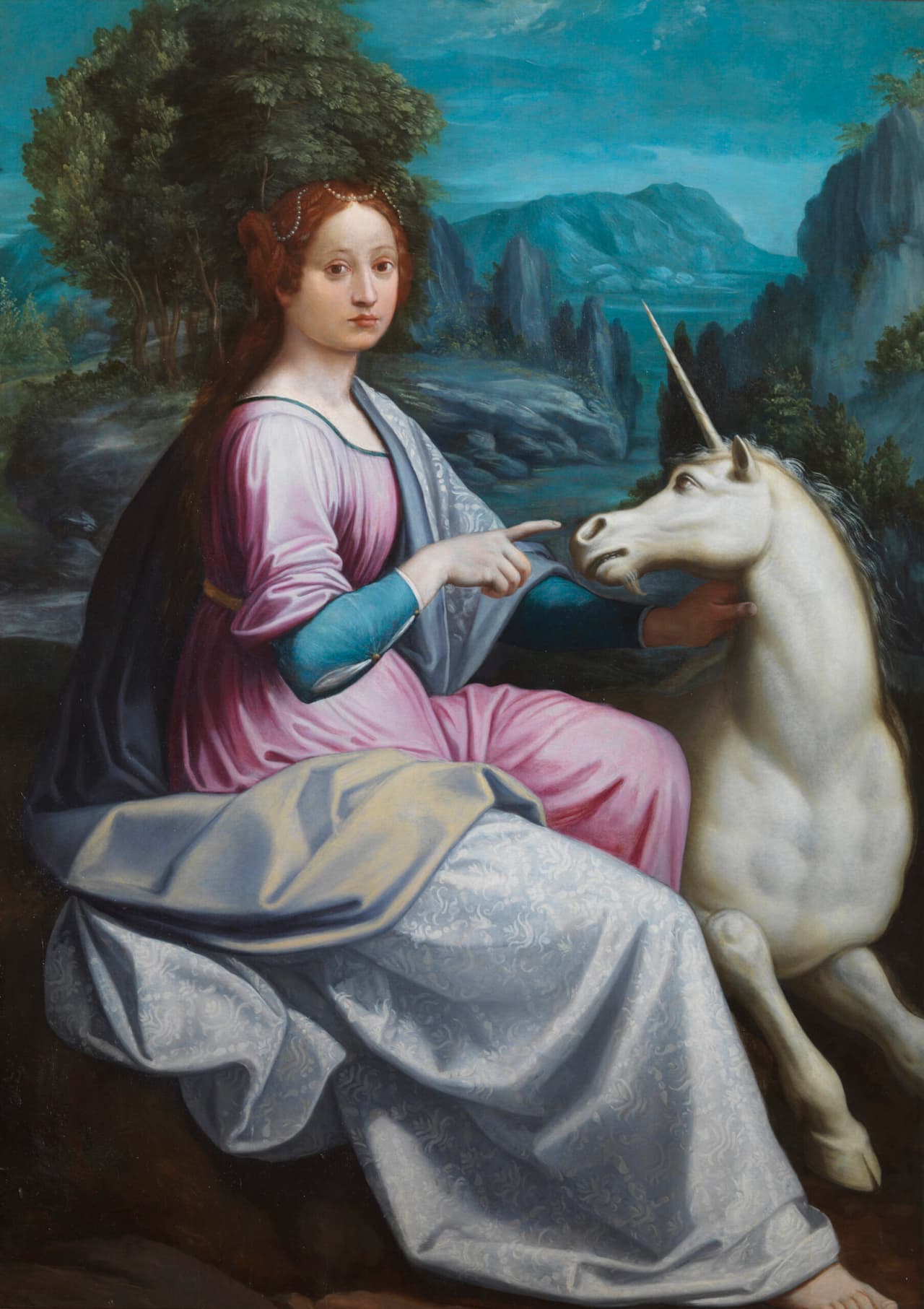
Young woman with unicorn: Source Wikimedia
In the painting, a young woman is immersed in a serene and transparent landscape, seated next to a unicorn and facing the viewer. With an inviting gesture, the woman points at the animal, which in turn seems to be looking towards her. It is assumed that the figure depicted is Giulia Farnese, the influential sister of Pope Paul III, depicted with heraldic symbols. The Virgin with the Unicorn, symbol of purity, was the emblem of the Farnese family for several generations.
The artist who created this portrait is Luca Longhi, a Romagnolo painter known for his family portraits and influenced by Leonardo’s style, especially in his use of light, especially in the landscapes that form the background of his works. Some scholars, however, suggest that the author of the painting may have been the painter’s daughter, Barbara, about whom little is known. The composition, however, is based on a drawing by Leonardo kept at the Ashmolean Museum in Oxford.
The melancholic and distant gaze of the young woman seems to freeze the image in a moment of reflection, almost a warning or a symbol. This idealisation may have been requested by the commissioning family, as the work was executed after Giulia’s death in 1524.
Saint Jerome by Lorenzo Lotto

In a wild and inhospitable landscape, the saint Jerome, a paternal figure of the Church, is portrayed in his dual guise of scholar and penitent. In the foreground, accompanied by the faithful lion, symbol of his legendary friendship with animals, he is in a pose evoking the ancient statue of a river god, absorbed in meditation on the Holy Scriptures. Saint Jerome was the first translator of the Bible into Latin, and here we see him immersed in his work of study and contemplation.
In the distant background to the left, on a rocky outcrop, the figure of Saint Jerome stands out, fervently addressing the crucifix. As the saint’s gaze turns to the right, the landscape gradually softens, revealing the presence of a castle that recalls Castel Sant’Angelo due to its shape and the proximity of the bridge over a bend in the river. This view, corresponding to the perspective from the Janiculum Hill, has made it possible to identify the painting’s original location in the Church of Sant’Onofrio, specifically in the chapel dedicated to Saint Jerome, which belonged to the archbishop of Taranto, Enrico Bruni.
Bruni, an influential member of the Roman Curia, favoured Lorenzo Lotto’s introduction to the Vatican rooms in 1509, thus beginning the artist’s prestigious career.
Luca Signorelli, Madonna and Child with Saints
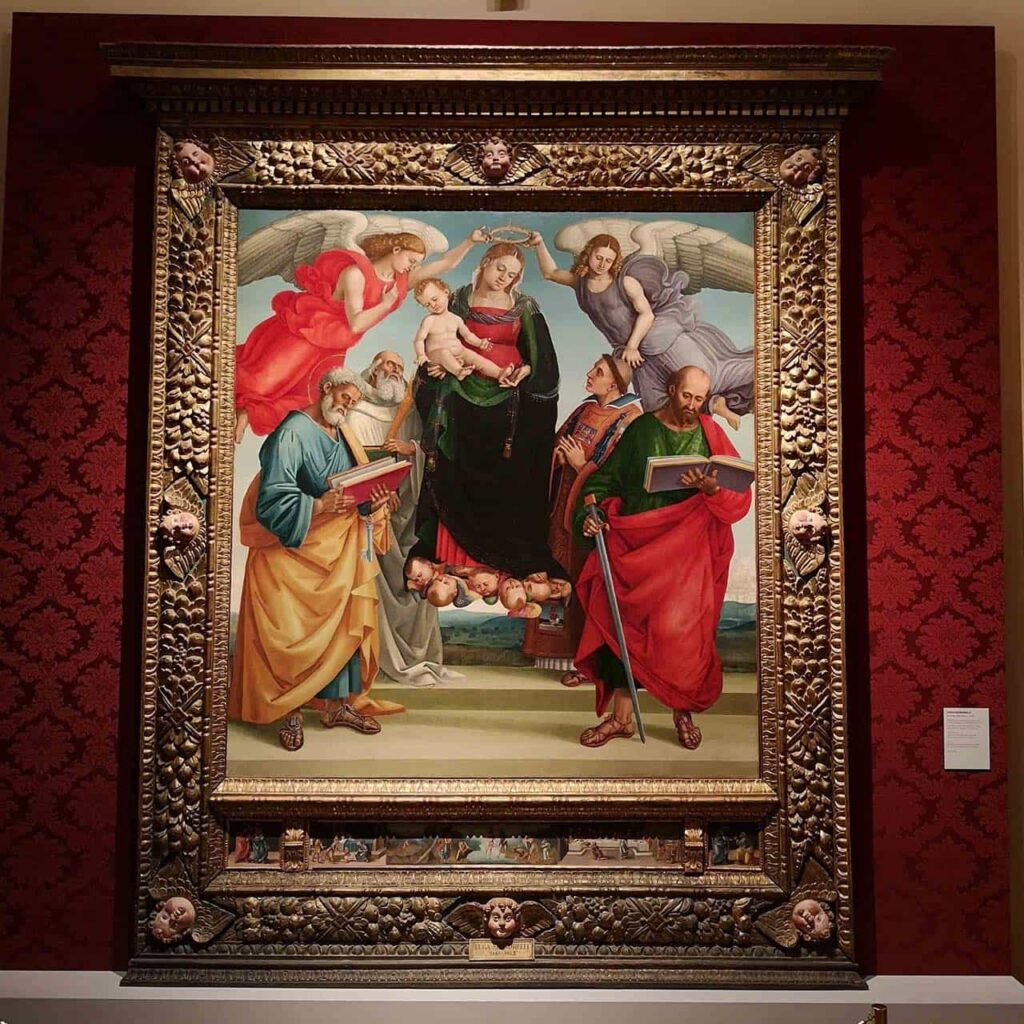
The altarpiece, commissioned by the nuns of the convent of San Michelangelo in Cortona and mentioned in the artist’s will, reveals the hallmarks of Luca Signorelli’s mature style. Signorelli, who was profoundly influenced by the school of Piero della Francesca, clearly shows this legacy, especially in the compact brilliance of the colours and the monumental construction of the figures. However, in contrast to the composure typical of Piero della Francesca’s style, his work denotes a greater attention to anatomical detail and a more pronounced dynamism, the result of his Florentine experience and the influence of artists such as Pollaiolo.
This innovative style aroused the interest of young artists such as Michelangelo, who was present with Signorelli at the court of Lorenzo the Magnificent in Florence. Signorelli, with his approach that balanced an austere spirituality, typical of the Middle Ages, with an extreme plastic rendering that challenged the traditional patterns of 15th century painting, proved to be a perfect witness to the transitional period of artistic values at the end of the 15th century. This contrast is also reflected in his most famous work, the cycle of the Apocalypse in the Chapel of San Brizio at Orvieto Cathedral (1499-1502).
In the altarpiece, which may have been his last work, the figure of the Virgin stands out for its masterful execution compared to the other characters represented, such as the angels and saints. The Virgin, just lifted into the air on a cloud of cherubs, emerges as a gigantic figure in a space dominated by the other figures. The altarpiece came to the museum with a predella depicting Stories of the Baptist, whose relationship with the main work has been questioned since the time of its donation.
Pellegrino Tibaldi – Saint Michael Archangel

Pellegrino Tibaldi, a painter and architect originally from Lombardy but with an established artistic education in Bologna, entered Rome probably as early as 1543. Here he distinguished himself by working alongside Daniele da Volterra at the Orsini Chapel in Trinità dei Monti and collaborating with Perin del Vaga in the decoration of the Sala Regia in the Vatican and Castel Sant’Angelo.
From Daniele da Volterra, Tibaldi acquired a strongly plastic style, clearly influenced by Michelangelo, while from Perin del Vaga he embraced a more refined intellectualism. Before Perin’s death, Tibaldi established himself as one of the main executors of his designs for Castel Sant’Angelo, also demonstrating considerable autonomy in the creative process.
In the painting of the archangel Michael, protector of the castle, Tibaldi depicts the figure in a sumptuous cloak and short armour blown by the wind. The mighty figure of the archangel seems to move impetuously forward while unsheathing his sword, recalling the legendary moment of the angelic apparition on top of the castle and the subsequent end of the plague.
In 1549, Tibaldi produced the Adoration of the Shepherds, now in the Galleria Borghese, where one can see the same sculptural forms of the characters, their intense gestures and a perspective that follows their movements. After his experience at Castel Sant’Angelo, Tibaldi continued the compositional schemes he had learnt during his stay in Rome at Palazzo Poggi in Bologna in 1552.
Perin del Vaga – Alexander the Great has the works of Homer placed in a casket
The scene depicts the moment when Alexander the Great orders the Homeric poems to be kept in a casket, a gesture that celebrates the refined culture and love of classical texts of Paul III Farnese, the pope who commissioned the work. This iconographic choice emphasises the resemblance between the pope and the Macedonian ruler of Antiquity, known not only for his military exploits, but also for his connection with Aristotle.
Perino del Vaga, the painter responsible for the fresco, made the preparatory cartoons for this scene and left the painting to his collaborators, thus following the practice inherited from his master Raphael. Pellegrino Tibaldi and Domenico Zaga, who took over the leadership of the site after Perino’s death, were mainly responsible for the execution of the monochrome panels along the two largest sides of the hall.
The Sala Paolina was decorated between January and July 1547, and in addition to the casket scene with the Homeric poems, other scenes related to Alexander the Great were painted. On the right side of the hall, next to the casket scene, are depictions of Alexander cutting the Gordian knot and his clemency towards the family of Darius. On the left side, however, there are scenes of Alexander making peace between two comrades and consecrating the arks of the Covenant.
Despite the different hands involved in the execution, the scenes are stylistically homogeneous. The monumentality of the figures and the solemn tone of the decorative cycle recall a direct comparison with masterpieces such as Michelangelo’s Last Judgement in the Sistine Chapel.
Perin del Vaga – Cupid and Psyche
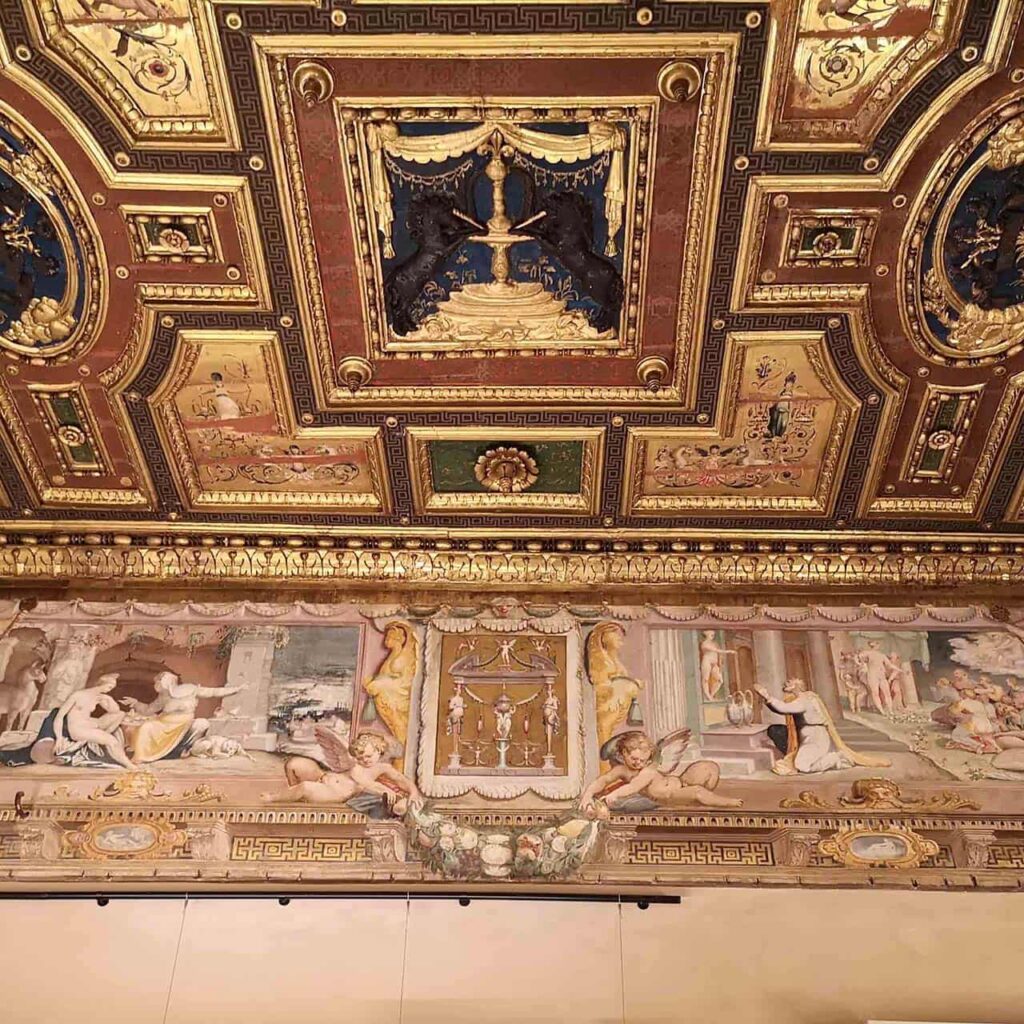
The most famous panel in the Hall of Cupid and Psyche at Castel Sant’Angelo was designed by Perin del Vaga, along with the others that make up the fresco cycle. The inspiration for this work was taken from the thirteenth of 33 engravings created by the Maestro del Dado and Agostino Veneziano, based on drawings by the Flemish artist Michiel Coxcie between 1532 and 1535, which were very popular at the time.
The panel is divided into three distinct moments, following the temporal order from right to left. On the right, Psyche wounds herself with Love’s arrow, shrouded in shadow. In the centre, Psyche, holding a lamp, approaches her sleeping bridegroom, who has abandoned his weapons. On the left-hand side, Love, awake and disappointed, flies away leaving Psyche in despair, as narrated in Book V, Chapter 23 of Apuleius’ Golden Ass.
While the composition faithfully follows the model of the engraving, Perino del Vaga’s style is fully manifested in the way he depicts the scene. His style combines Raphaelesque naturalistic harmonies with an intellectual abstraction, influenced by the sophisticated mannerism of Rosso Fiorentino and Primaticcio.

The central scene opens up towards the spectator like a stage, bordered by the bed canopy and lit by the lamp held by Psyche, which reflects the light onto the figures. The figures of the lovers are softly modelled, with long, slender limbs that stand out against the white of the sheets, contrasting with the red curtains.
This cycle of frescoes depicting the fable of Cupid and Psyche was a reference point for other similar works executed after the mid-16th century, such as those in Palazzo Spada Capodiferro and Palazzo Vitelli in Sant’Egidio, both of which were executed in the following decade.
Perin del Vaga – Perseus
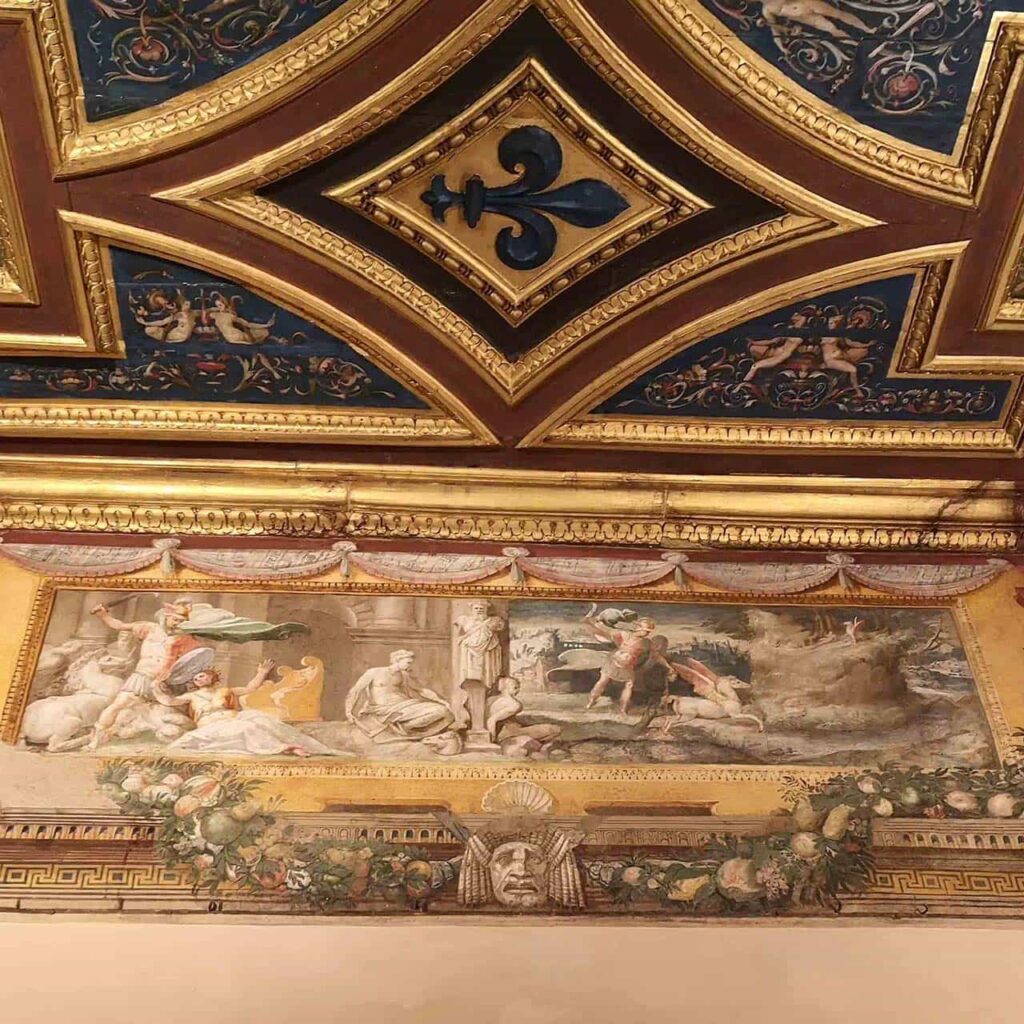
The realisation of the ceiling and frieze of the Perseus Room took place between August 1545 and May 1546, at the same time as work was undertaken in the adjacent rooms of Cupid and Psyche and Pauline, as well as in the Sala Regia in the Vatican. It is likely that the Perseus stories, designed by Perino del Vaga as evidenced by the numerous preparatory drawings, were completed by collaborators. However, this does not detract from the fact that the fresco cycle is of very high pictorial quality.
The concluding scene comprises three distinct episodes. On the left, Perseus is depicted stooped, his weapons laid down, having returned from the feat that saw him defeat the sea monster threatening Andromeda. This episode is recalled in the background behind him. From Medusa’s severed head, the gushing blood miraculously gives birth to coral, while dancing maidens in the waters of the sea witness this prodigy. On the right, in the distance, the wedding banquet between Perseus and Andromeda takes place in open architecture, behind which a city immersed in an unreal atmosphere can be glimpsed.
The almost kinetic dynamism that merges different sequences of the story in the same space strikes the observer. The faithfulness to the design of the finished work demonstrates that the autonomy of the executor (probably Domenico Zaga or Prospero Fontana) was limited compared to the design phase, thus ensuring substantial homogeneity with the rest of the frieze. The episodes depicted, culminating in the happy wedding banquet, symbolise the return to order and harmony after the trauma of the Reformation.
Ambrogio Zavattari and workshop, Polyptych
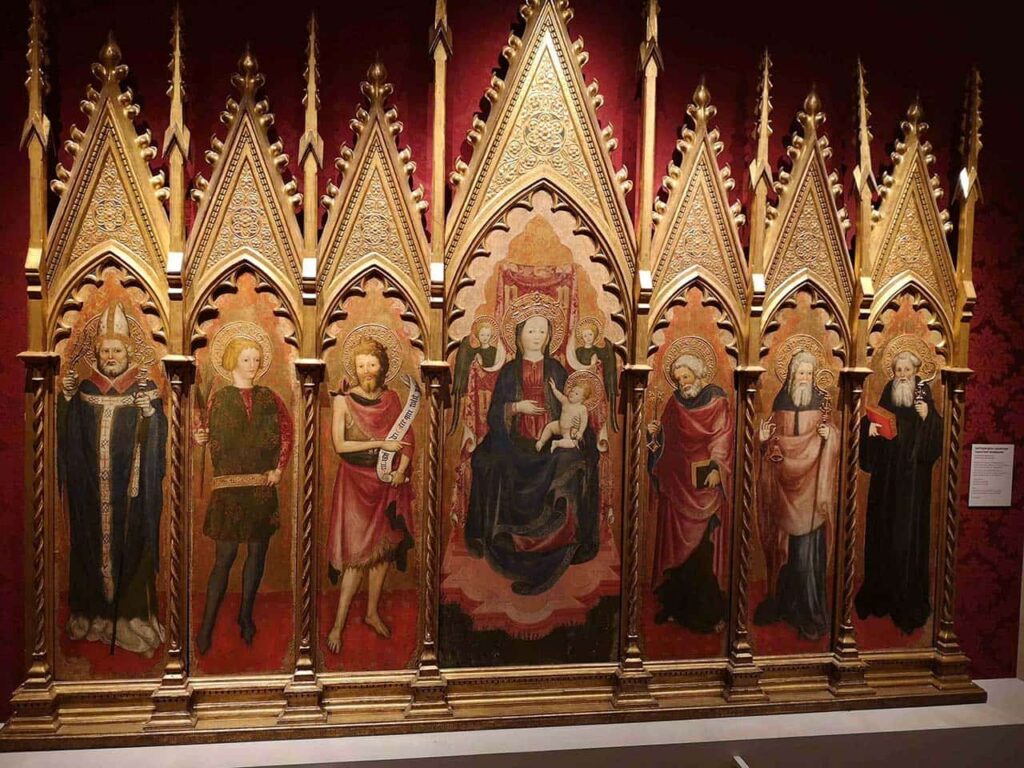
The polyptych attributed to the Zavattari was dated between 1444 and 1450 by the critic Roberto Longhi, based on stylistic comparisons with the fresco cycle illustrating the Stories of Theodolinda in Monza Cathedral. This cycle, dated 1444, is an autograph work of the Zavattari family, who were among the main exponents of the Gothic courtly style in Lombardy.
Five of the seven panels of the polyptych came to the National Museum of Castel Sant’Angelo included in a 19th-century neo-Gothic frame. The other two panels, depicting St. Benedict and St. Anthony Abbot, were identified as parts of the same polyptych in 1957 and only acquired by the Museum in 2000.
The original location of the polyptych remains unknown, but it has been suggested that it may have been destined for the altar of Milan Cathedral, given the presence of Saint Ambrose and Saint Victor, two saints particularly venerated in the Lombard city.

Castel Sant’Angelo Rome Tickets: Quick Access.
Buy online. Choose your preferred time. Visit Rome’s Castel Sant’Angelo, Hadrian’s Tomb, the papal quarters, the fortress and much more.
You can cancel free of charge up to the day before the visit.
Statues and Sculptures
Saint Michael Archangel by Raffaello da Montelupo (Raffaele Sinibaldi)
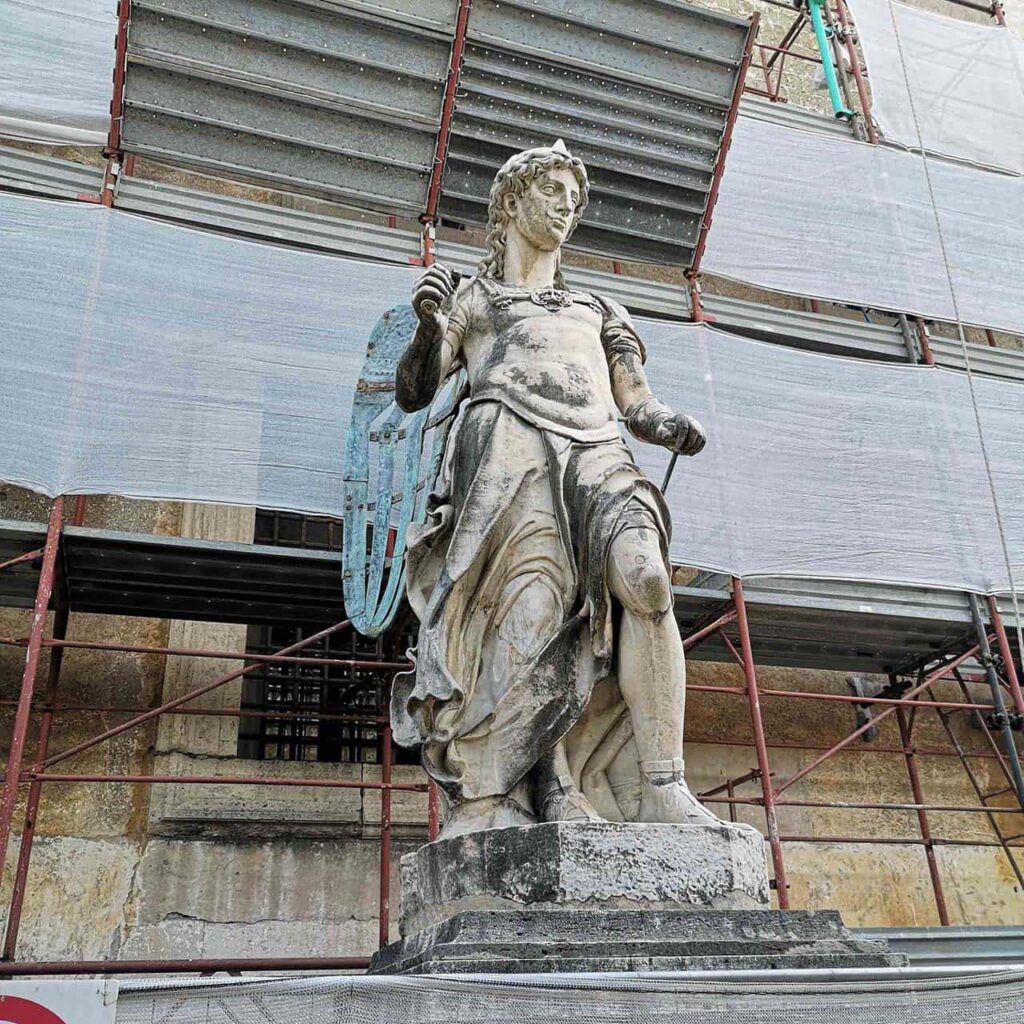
The statue of St. Michael the Archangel, attributed to the sculptor and architect dear to Paul III, was identified thanks to the discovery of payments made between July and October 1544. It is the only surviving sculpture among the numerous representations of the Archangel that once adorned the top of the castle before being replaced in the 18th century.
In the statue, St. Michael wears a long robe, in line with the late medieval iconographic tradition, while the helmet at his feet has a shape common in the first half of the 15th century. The cuirass is held by shoulder straps displaying the Farnese fleur-de-lis, the symbol of the patron’s family, and the oversized head is justified by its original location, which involved a bottom-up view.
The original statue had painted and gilded metal wings, perforated to reduce wind friction. This version is believed to be quite faithful to the prototype made around 1450 for Nicholas V, which was lost in the 1492 explosion. However, the face of the Angel shows a peculiarity, recalling that of the statue of Leah in the tomb of Julius II in San Pietro in Vincoli, where Montelupo, the sculptor of this work, collaborated with Michelangelo.
The statue of St. Michael was restored by Gian Lorenzo Bernini in 1660 after severe damage and was replaced by a bronze statue by Pieter Anton Verschaffelt in 1752. It was first transported to a niche in the cordonade of Paul III and then placed in the courtyard named after him in 1910.
Peter Anton Verschaffelt – San Michele Arcangelo
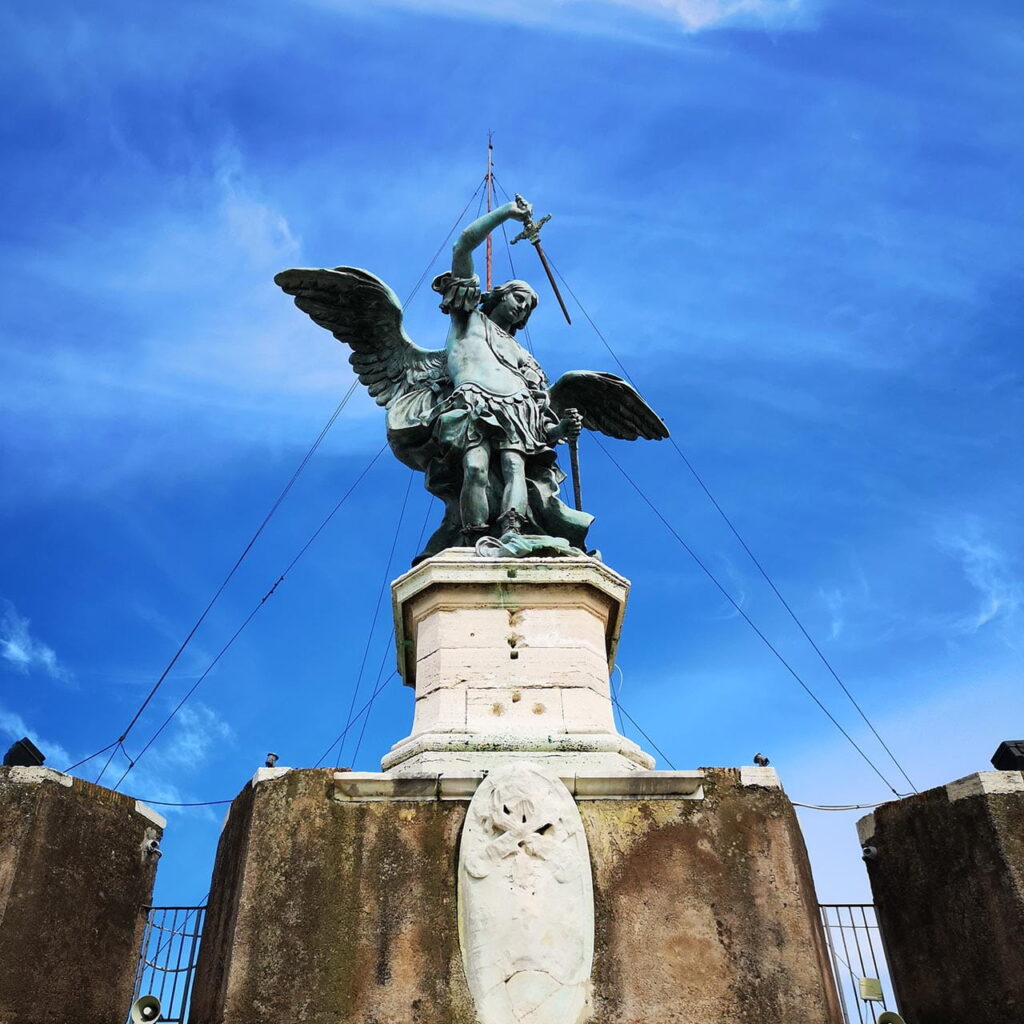
In 1746, Pope Benedict XIV Lambertini announced a competition for a new Statue of the Angel for Castel Sant’Angelo, on the occasion of the Jubilee of 1750. The winner of this competition was the Flemish Peter Anton Verschaffelt, who had received his training in Paris under the sculptor Edmé Bouchardon and had already distinguished himself in Rome as a portrait painter of the pope.
The realisation of the statue encountered some difficulties due to the large amount of metal needed. It was cast in Civitavecchia by Francesco Giardoni and inaugurated on the top of Castel Sant’Angelo only on 28 June 1752. Originally, the statue was covered with a golden surface, except for the armour, which was covered with silver foil.
The 35-piece angel statue was made using the casting technique known as ‘good form’, a variant of the ‘lost wax’ technique. An internal framework, consisting of two crossed main pins, was used to support the structure. This original framework was replaced in 1986 with one made of stainless steel and titanium and is now on display in the Rotunda Hall.
Bust of Emperor Hadrian
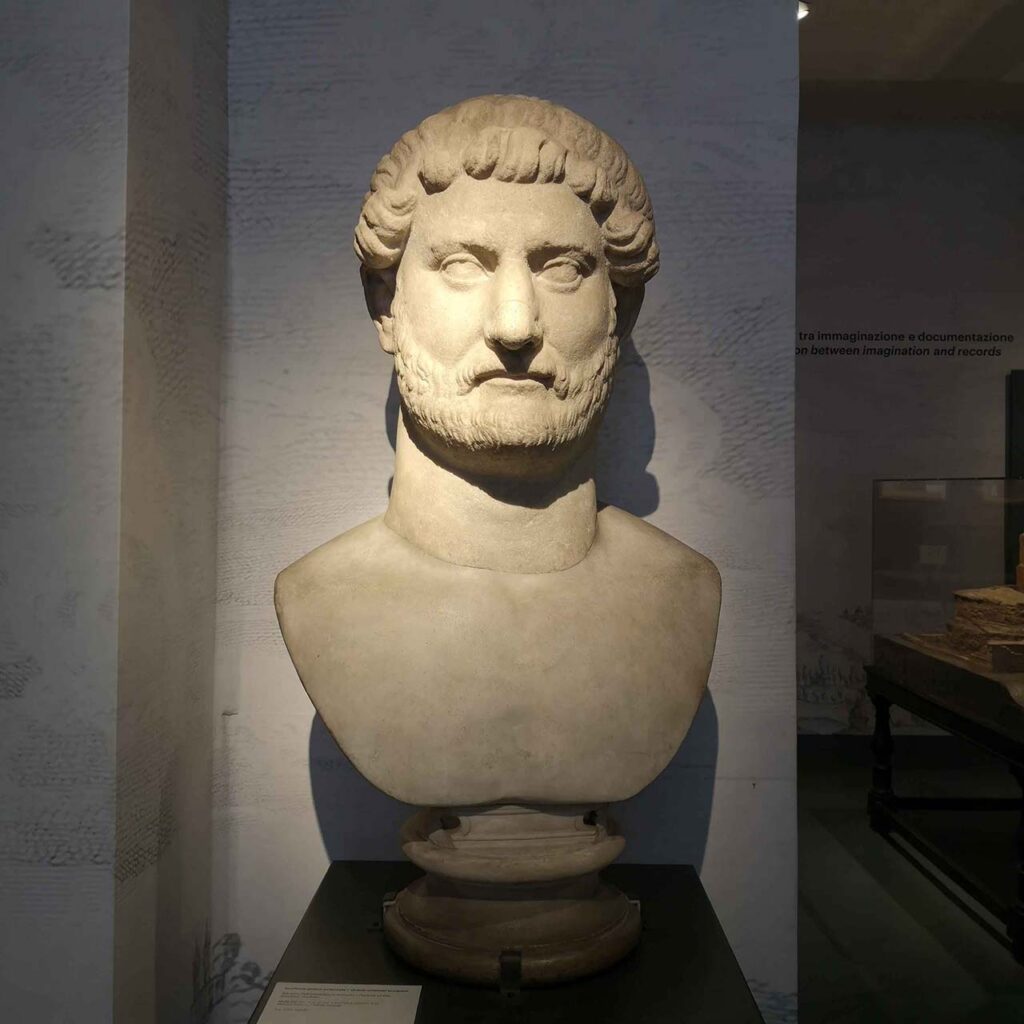
Capital fragments
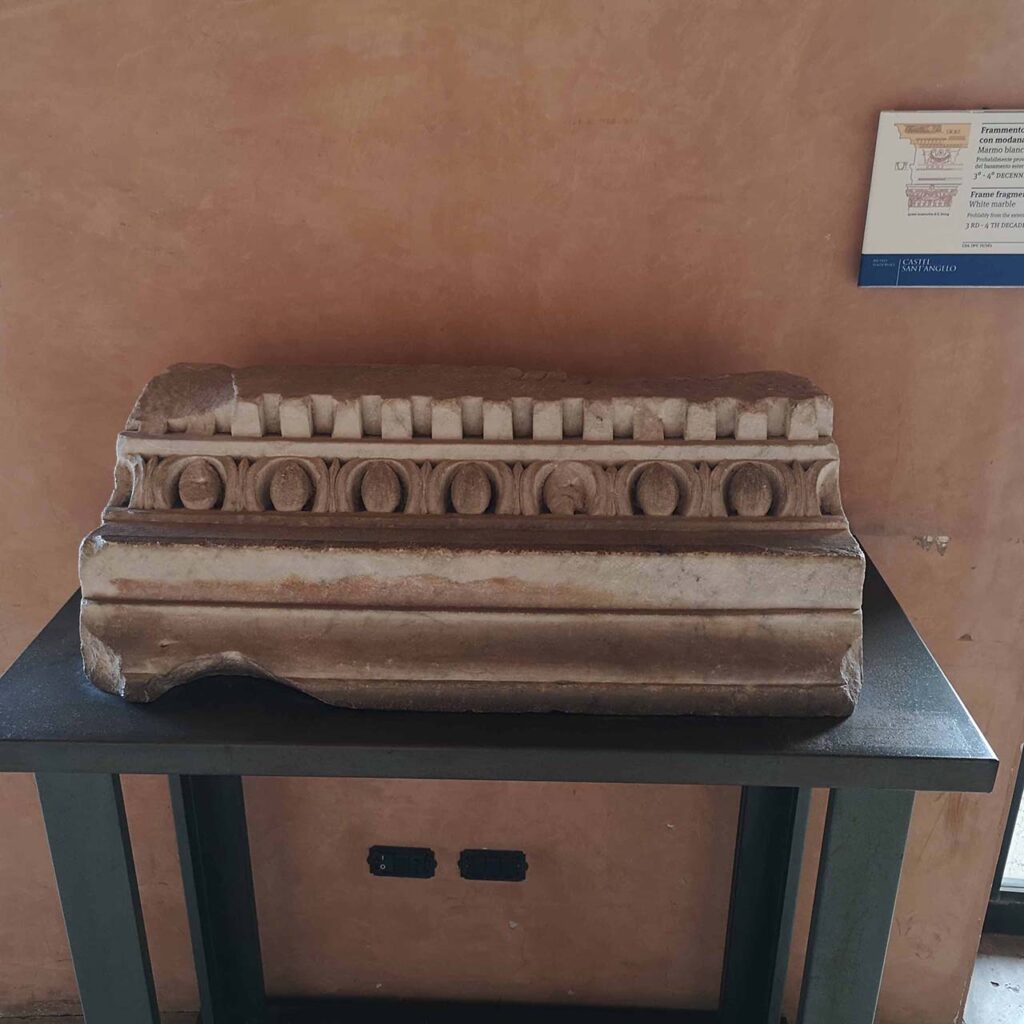
Fragments of statues
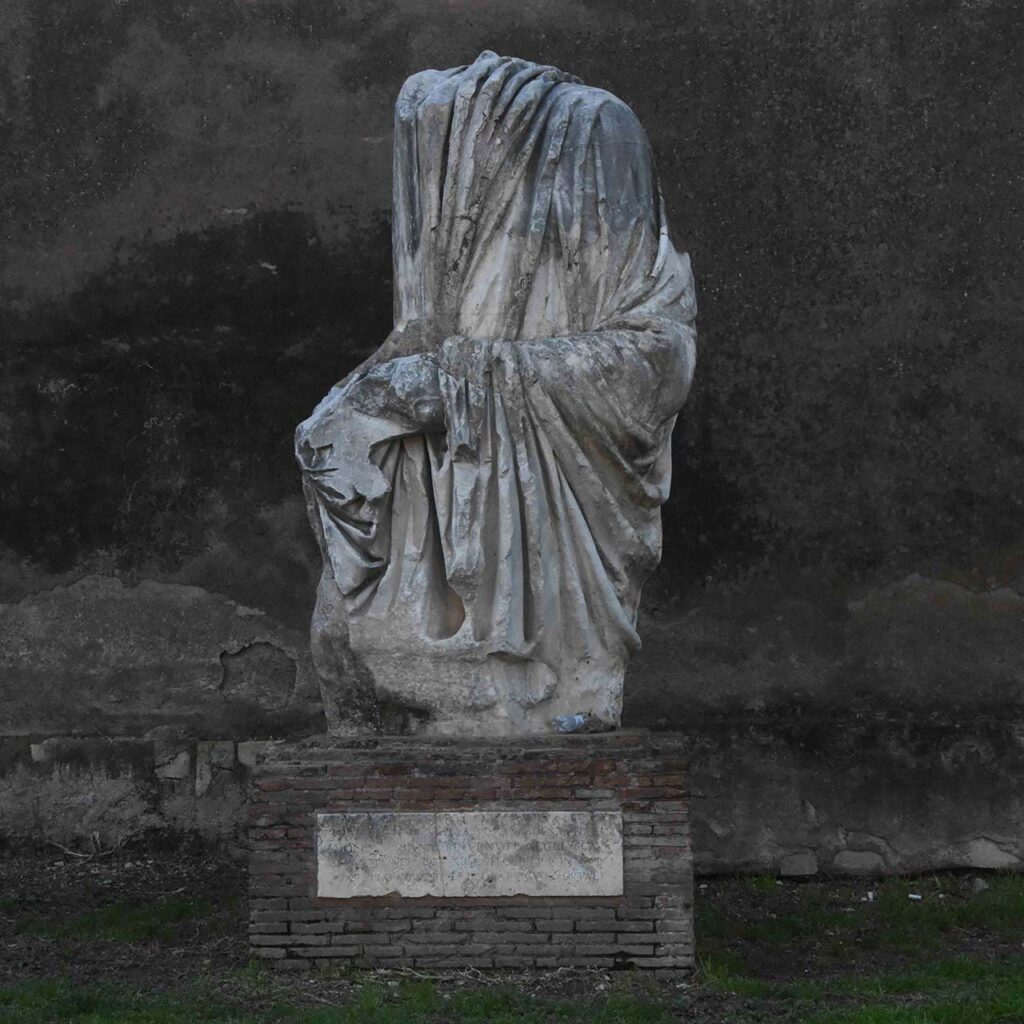
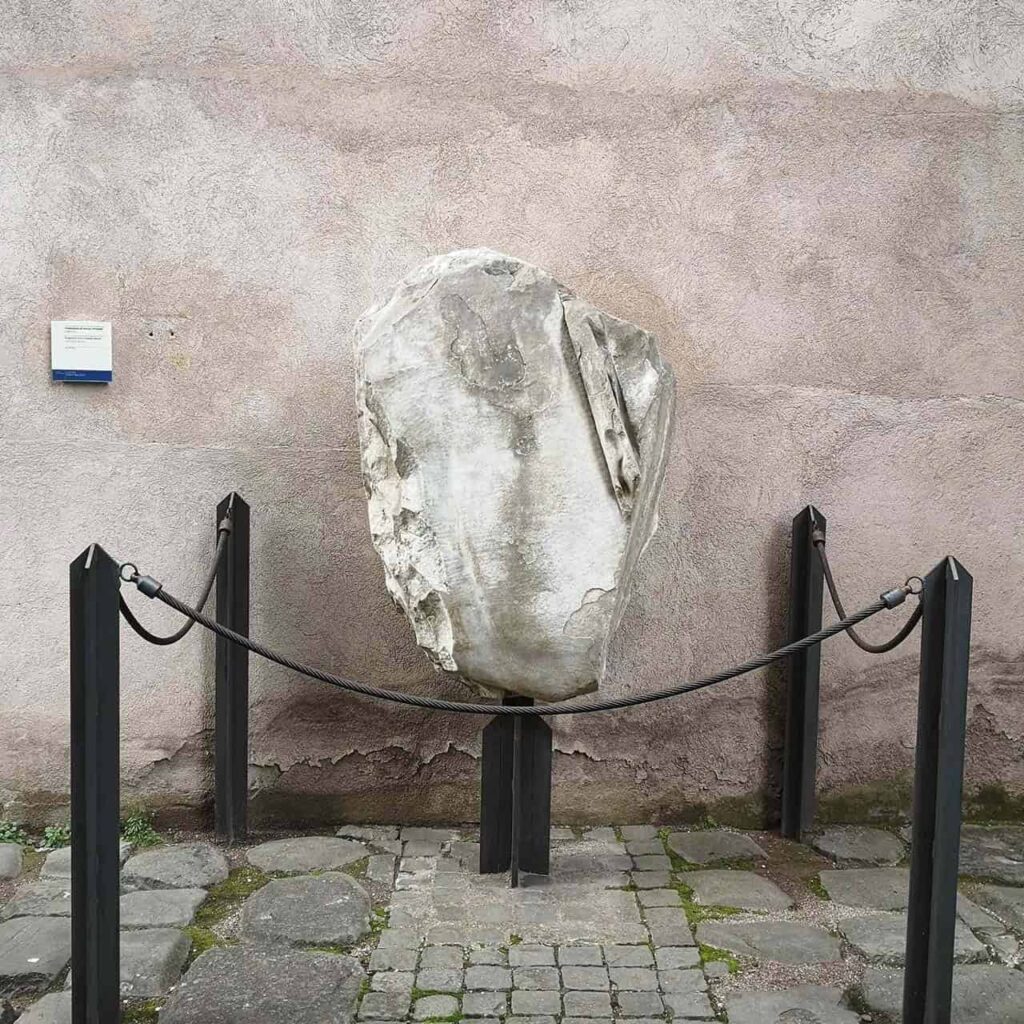
Bust of Hadrian
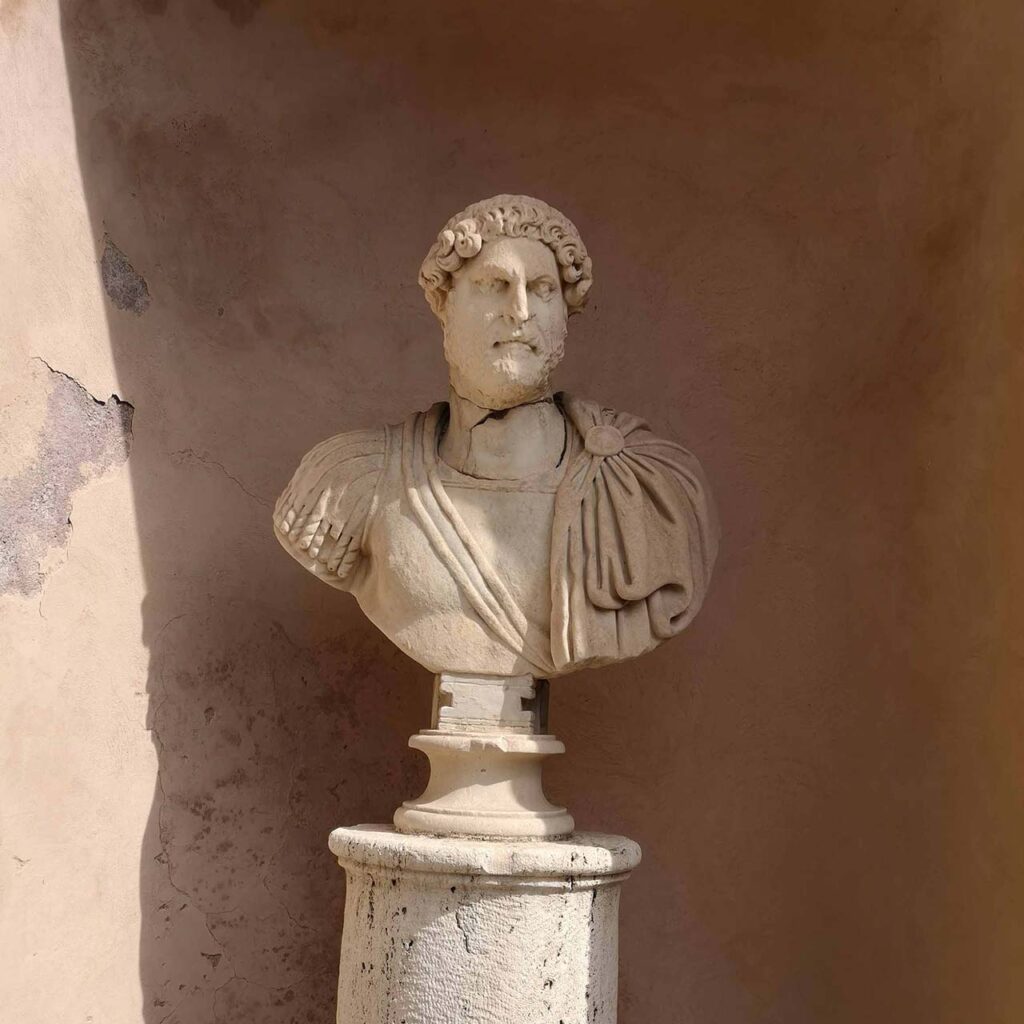
Bust of Togato
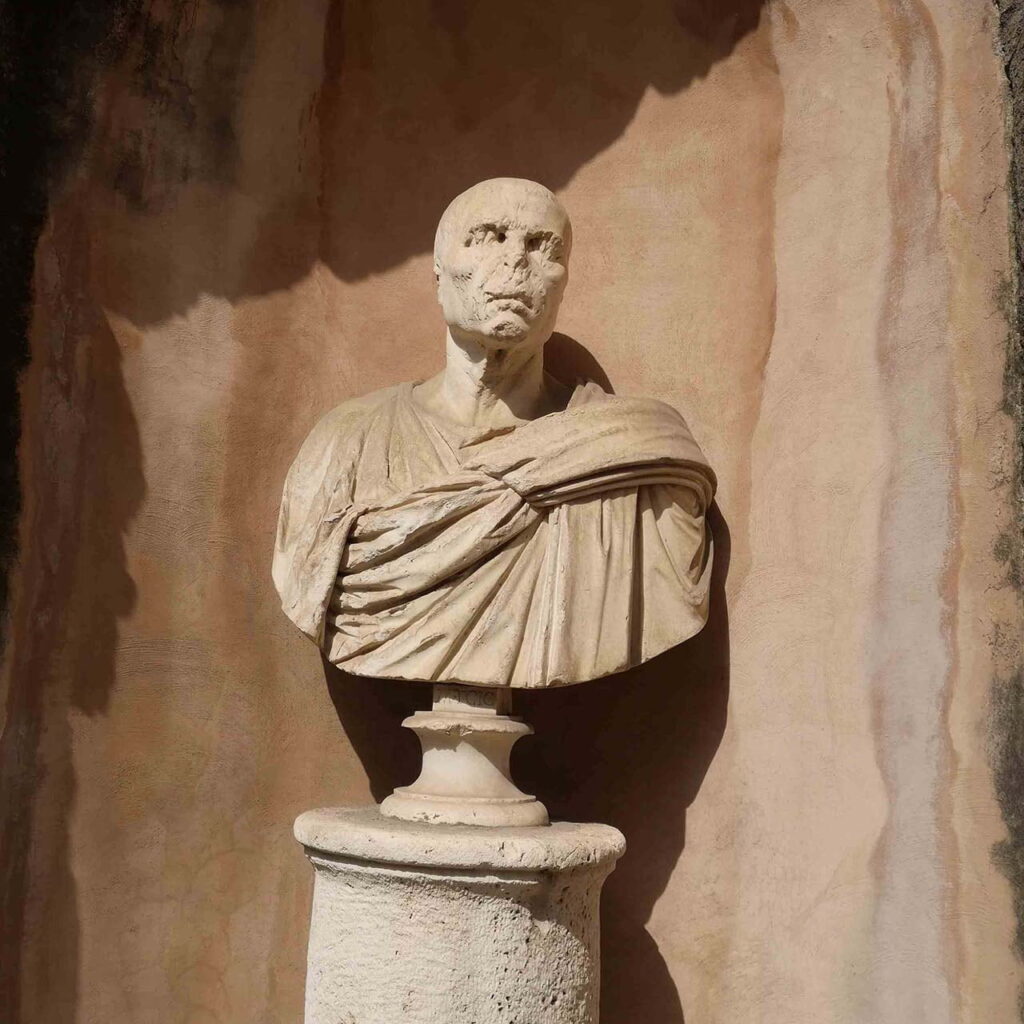
These works, with their variety and beauty, enrich the artistic heritage of Castel Sant’Angelo, offering visitors an unforgettable experience and a journey through history and art.


